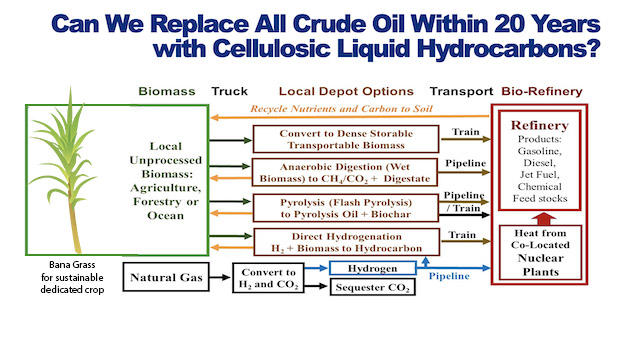
By Charles Forsberg (
cforsber@mit.edu) and Bruce Dale (bdale@egr.msu.edu)
Special to The Digest
In the United States, crude oil products provide 48% of the total energy to the final customer: residential, commercial, industrial and transportation. Replacement of crude oil products (gasoline, diesel, jet fuel, chemical feed stocks, etc.) made from non-fossil-fuel carbon sources, principally products made from cellulosic biomass, would decarbonize about half the U.S. economy.
Within this context, we asked four questions to determine the technical and economic viability of this option [1-4]. First, what is the long-term demand for liquid hydrocarbons? Second, can we replace all crude oil with liquid bio-fuels derived from cellulosic materials? Cellulosic biomass is the primary form of biomass on earth and is not a food for humans. Plants remove carbon dioxide from the atmosphere to grow; thus, converting plant matter into gasoline, diesel and jet fuel and then burning these products does not increase atmospheric carbon dioxide levels. Third, what are the hydrogen and heat requirements to convert cellulosic biomass into liquid hydrocarbons? Finally, how fast can we transition away from crude oil in an affordable manner?
There is sufficient cellulosic biomass, to replace crude oil without large impacts on food and fiber prices. However, massive quantities of hydrogen and heat must be supplied to large integrated bio-refineries to convert the biomass. This strategy would result in a quarter to half of U.S. natural gas consumption being used to produce hydrogen with co-produced carbon dioxide sequestered underground to avoid increasing the carbon dioxide content of the atmosphere. In the near-term, using natural gas is the lowest cost hydrogen production option and the only option that can deployed at the scale required.
In the longer-term, low-cost hydrogen may be available from nuclear and agricultural biomass sources. Heat to the refineries would ultimately be provided by nuclear reactors; likely becoming the largest market for nuclear energy. Involving the agriculture sector enables the total system to have large negative carbon dioxide emissions—reducing atmospheric carbon dioxide levels to potentially become a very large biological energy with carbon capture and storage (BECCS) system. This option could potentially replace most crude oil in 20 years because it is based on American strengths in agriculture and the oil/gas industry. It would also use mostly existing technologies and infrastructure, thereby reducing the cost and shortening the time required for this large scale energy transition.
Read More
 By Charles Forsberg (cforsber@mit.edu) and Bruce Dale (bdale@egr.msu.edu)
Special to The Digest
In the United States, crude oil products provide 48% of the total energy to the final customer: residential, commercial, industrial and transportation. Replacement of crude oil products (gasoline, diesel, jet fuel, chemical feed stocks, etc.) made from non-fossil-fuel carbon sources, principally products made from cellulosic biomass, would decarbonize about half the U.S. economy.
Within this context, we asked four questions to determine the technical and economic viability of this option [1-4]. First, what is the long-term demand for liquid hydrocarbons? Second, can we replace all crude oil with liquid bio-fuels derived from cellulosic materials? Cellulosic biomass is the primary form of biomass on earth and is not a food for humans. Plants remove carbon dioxide from the atmosphere to grow; thus, converting plant matter into gasoline, diesel and jet fuel and then burning these products does not increase atmospheric carbon dioxide levels. Third, what are the hydrogen and heat requirements to convert cellulosic biomass into liquid hydrocarbons? Finally, how fast can we transition away from crude oil in an affordable manner?
There is sufficient cellulosic biomass, to replace crude oil without large impacts on food and fiber prices. However, massive quantities of hydrogen and heat must be supplied to large integrated bio-refineries to convert the biomass. This strategy would result in a quarter to half of U.S. natural gas consumption being used to produce hydrogen with co-produced carbon dioxide sequestered underground to avoid increasing the carbon dioxide content of the atmosphere. In the near-term, using natural gas is the lowest cost hydrogen production option and the only option that can deployed at the scale required.
In the longer-term, low-cost hydrogen may be available from nuclear and agricultural biomass sources. Heat to the refineries would ultimately be provided by nuclear reactors; likely becoming the largest market for nuclear energy. Involving the agriculture sector enables the total system to have large negative carbon dioxide emissions—reducing atmospheric carbon dioxide levels to potentially become a very large biological energy with carbon capture and storage (BECCS) system. This option could potentially replace most crude oil in 20 years because it is based on American strengths in agriculture and the oil/gas industry. It would also use mostly existing technologies and infrastructure, thereby reducing the cost and shortening the time required for this large scale energy transition.
Read More
By Charles Forsberg (cforsber@mit.edu) and Bruce Dale (bdale@egr.msu.edu)
Special to The Digest
In the United States, crude oil products provide 48% of the total energy to the final customer: residential, commercial, industrial and transportation. Replacement of crude oil products (gasoline, diesel, jet fuel, chemical feed stocks, etc.) made from non-fossil-fuel carbon sources, principally products made from cellulosic biomass, would decarbonize about half the U.S. economy.
Within this context, we asked four questions to determine the technical and economic viability of this option [1-4]. First, what is the long-term demand for liquid hydrocarbons? Second, can we replace all crude oil with liquid bio-fuels derived from cellulosic materials? Cellulosic biomass is the primary form of biomass on earth and is not a food for humans. Plants remove carbon dioxide from the atmosphere to grow; thus, converting plant matter into gasoline, diesel and jet fuel and then burning these products does not increase atmospheric carbon dioxide levels. Third, what are the hydrogen and heat requirements to convert cellulosic biomass into liquid hydrocarbons? Finally, how fast can we transition away from crude oil in an affordable manner?
There is sufficient cellulosic biomass, to replace crude oil without large impacts on food and fiber prices. However, massive quantities of hydrogen and heat must be supplied to large integrated bio-refineries to convert the biomass. This strategy would result in a quarter to half of U.S. natural gas consumption being used to produce hydrogen with co-produced carbon dioxide sequestered underground to avoid increasing the carbon dioxide content of the atmosphere. In the near-term, using natural gas is the lowest cost hydrogen production option and the only option that can deployed at the scale required.
In the longer-term, low-cost hydrogen may be available from nuclear and agricultural biomass sources. Heat to the refineries would ultimately be provided by nuclear reactors; likely becoming the largest market for nuclear energy. Involving the agriculture sector enables the total system to have large negative carbon dioxide emissions—reducing atmospheric carbon dioxide levels to potentially become a very large biological energy with carbon capture and storage (BECCS) system. This option could potentially replace most crude oil in 20 years because it is based on American strengths in agriculture and the oil/gas industry. It would also use mostly existing technologies and infrastructure, thereby reducing the cost and shortening the time required for this large scale energy transition.
Read More


